Market Overview
Overall market overview
The cryptocurrency market is on an upward trend this week, with the market and most Altcoins showing an upward trend. The recent sluggish market sentiment has been greatly alleviated, with the market sentiment index rising from 55% to 79%, entering the bullish range as a whole. The market value of stablecoins continued to rise from last week and continued to rise this week (USDT reached 145.7 billion and USDC reached 61.9 billion, with increases of 0.62% and 2.32% respectively), indicating that institutional funds have increased their entry efforts, with the growth rate of US funds being the main one. It can be seen that the rising market this week has greatly boosted the sentiment of US investors and started to accelerate their entry.
This week's rise was mainly due to the easing of the US's tariff policy towards China, Trump's statement that he did not intend to fire Fed Chairman Powell, and the new SEC Chairman Paul Atkins's appointment and his friendly attitude towards the crypto industry, which promoted the market's strong rebound this week. However, the market is still facing the uncertainty of the upcoming economic recession and tariffs in the United States, so this week's rise can only be seen as a rebound from the oversold situation some time ago, and cannot be seen as a reversal of the market.
Next week forecast
Bullish targets: SOL, SNX
SOL: The overall recovery of the Solana ecosystem, the rise of meme tokens, stablecoins and decentralized trading platforms drive market recovery
Meme Token Market Rebounds
This week, as the market rebounded, the trading volume of Meme tokens on the Solana chain increased significantly. The number of Meme tokens purchased continued to be higher than the number of sales, driving the rapid recovery of data on the Solana chain. This shows that although the retreat of the previous Meme wave caused losses to users on the chain, investors' interest in Meme tokens is still strong. And after Pump.fun launched PumpSwap, PumpSwap's daily trading volume gradually increased, maintaining between 300 million and 480 million US dollars, accounting for 9% to 19% of the DEX trading volume on the Solana chain. It can be seen that the Meme market is gradually recovering. The activity of the Meme token market will help to increase the price of SOL in the short term.

Solana chain Meme coin trading situation (data source: https://dune.com/pseudocode88_aux/solana-meme-token-analysis)
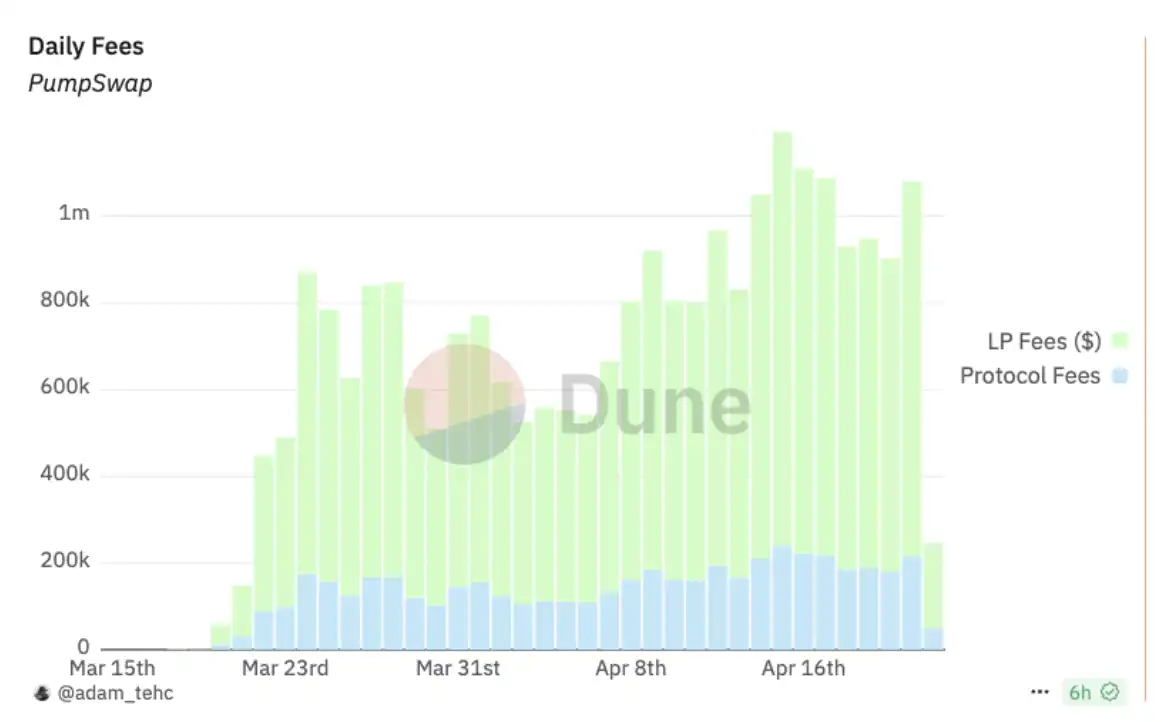
PumpSwap daily transaction volume (data source: https://dune.com/pseudocode88_aux/solana-meme-token-analysis)
On-chain stablecoin supply growth
The supply of stablecoins on the Solana chain continues to grow rapidly, and has now exceeded $12.8 billion, setting a new record high. This growth reflects investors' confidence in the Solana ecosystem and the demand for on-chain liquidity support. The sufficient supply of stablecoins provides important liquidity support for financial activities on the Solana chain and promotes the development of the on-chain ecosystem. This liquidity not only enhances the activity of on-chain transactions, but also provides investors with more trading and investment opportunities.
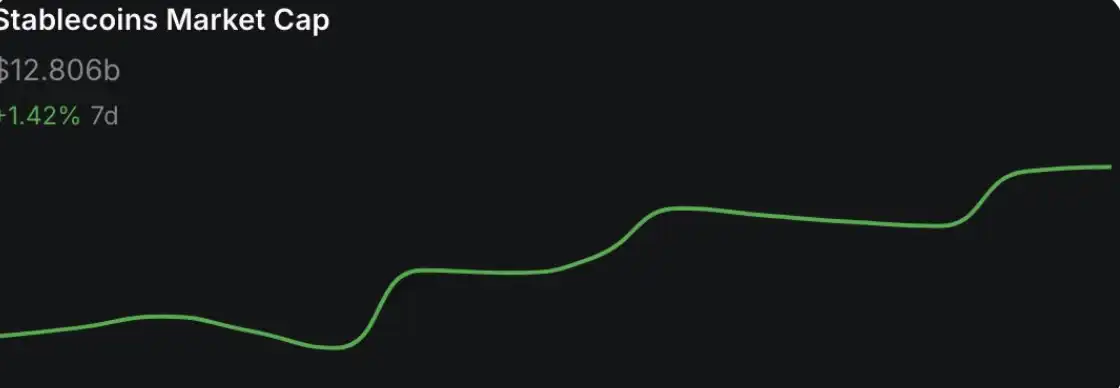
Solana on-chain stablecoin situation (data source: https://defillama.com/chain/solana)
Solana on-chain DEX transaction volume growth
The decentralized exchange (DEX) on the Solana chain has seen a trading volume of more than $3.5 billion in the past 24 hours, showing a recovery in on-chain activity. The supply of stablecoins has also continued to grow, recently exceeding $18.2 billion. This reflects investors’ confidence in the Solana ecosystem and provides more liquidity support on the chain.
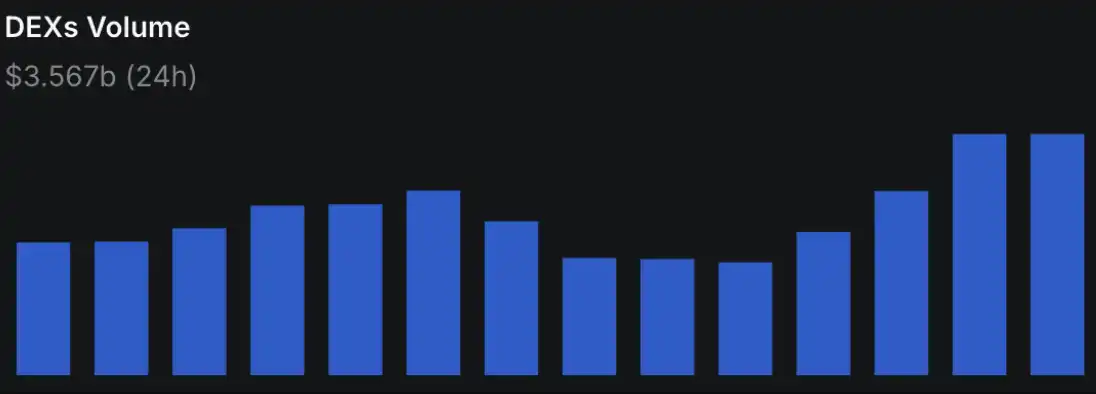
Solana on-chain DEX transaction volume (data source: https://defillama.com/chain/solana)
Solana Decentralization Policy
The Solana Foundation has introduced a new policy to strengthen decentralization. For new validators added to its delegation program, three of them will be removed if they have been eligible for Solana Foundation delegation on the mainnet for at least 18 months and have less than 1,000 SOL staked outside of the Foundation delegation. This policy aims to reduce reliance on Foundation delegation and encourage community-supported validators.
Institutional companies enter the market and increase their holdings
SOL Strategies, a Canadian listed investment company, issued $500 million in convertible bonds to purchase and pledge SOL. After SOL Strategies issued the news, SOL Strategies' stock price rose by 23.5%. SOL Strategies intends to learn from Michael Saylor's MicroStrategy and continue to issue convertible corporate bonds to increase its holdings of BTC in order to increase its stock price. Therefore, if SOL Strategies succeeds, it will have substantial support and benefits for the price of SOL. And the recent emerging trend is that traditional companies are gradually starting to increase their holdings of SOL in various ways.
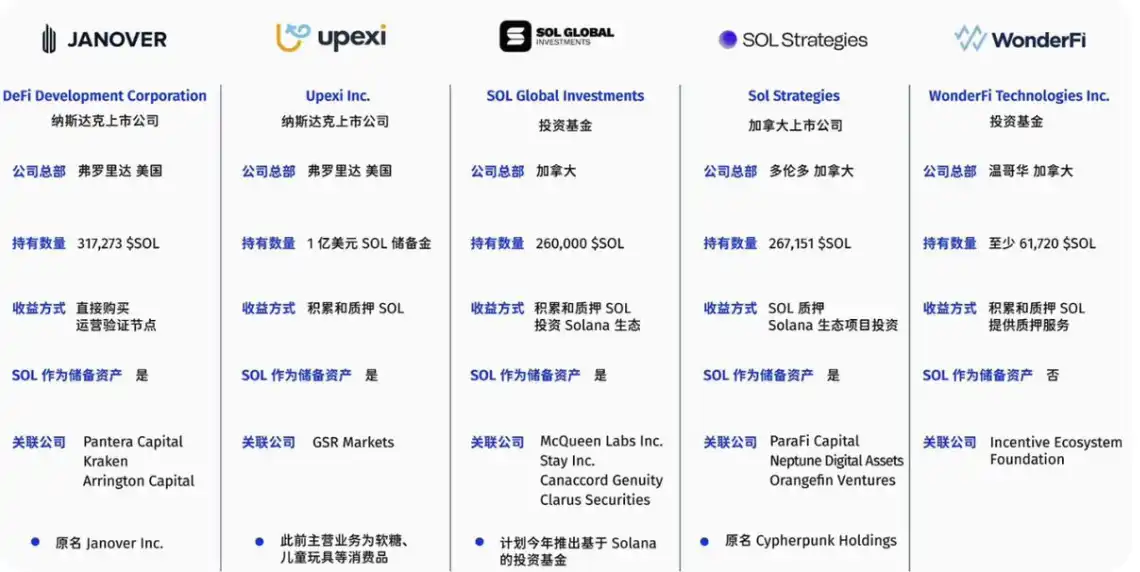
Good news for SOL spot ETF
SOL's spot ETF application has been delayed, but with the appointment of new SEC Chairman Paul Atkins, the situation may change. Paul Atkins is friendly to the crypto industry and regards the establishment of a clear digital asset regulatory framework as a top priority, which is good news for the approval of SOL spot ETF and may further drive up SOL prices.
SNX: From the depegging crisis to the hope of recovery, how Synthetix rebuilds market confidence
Recently, the algorithmic stablecoin sUSD issued by Synthetix suffered a serious depegging incident due to the adjustment of Synthetix's debt management mechanism in the SIP-420 proposal. The price of sUSD fell to as low as $0.68, and the price of Synthetix's token SNX also fell to as low as $0.55. The total locked value (TVL) of Synthetix reached a minimum of $72.23 million. Market investors' confidence in Synthetix has been shaken.
Remediation measures
Liquidity incentives: Synthetix increases the yield to 49.18% by staking sUSD/sUSDe LP on Convex to attract more liquidity.
Deposit incentives: Through the Infinex project, Synthetix incentivizes users to deposit sUSD, distributing 16,000 OP rewards to users who deposit more than 1,000 sUSD each week. The incentive lasts for six weeks.
Staking incentives: Allow users to stake sUSD to the 420 pool and receive 5 million SNX as an incentive after staking for one year.
Negative incentives and pledge optimization: Pledgers are required to deposit a certain proportion of sUSD. If the standard is not met, debt forgiveness will be suspended, and the proportion will be increased when the anchor deviates. At the same time, SNX pooled pledge will be implemented to expand the supply of sUSD and launch Perps V4 that supports multi-collateral and off-chain order matching.
Market reaction
Driven by these measures, the price of sUSD rebounded to a high of $0.88, and the price of SNX also rose to $0.74. In addition, the total locked value (TVL) of Synthetix increased from $72.23 million to $89.25 million, an increase of 23.56%.
Subsequent impact
Although the sUSD depegging problem has not been completely resolved, Synthetix's proactive measures have given the market hope for recovery. If the sUSD price can recover to $1, investors' confidence in Synthetix may be re-boosted, thereby promoting further increases in the SNX price.
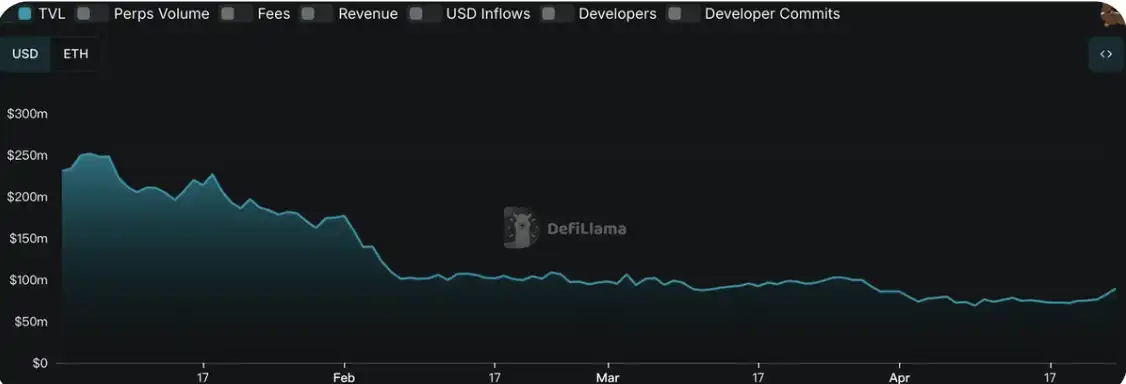
Synthetix TVL (data source: https://defillama.com/protocol/synthetix#information)
Bearish targets: REZ, OMNI
REZ: 8.64% of tokens unlocked in the context of Restaking downturn may trigger concentrated selling by investment institutions and teams
Renzo is a liquidity re-staking protocol based on the EigenLayer ecosystem, which aims to simplify complex staking mechanisms for end users and achieve rapid cooperation with EigenLayer node operators and active verification services (AVS). Due to the recent poor performance of the Ethereum ecosystem and the continued low price of ETH, the staking rate of ETH has also declined, causing the Restaking track project to lose market attention. REZ will unlock 864 million REZ tokens on April 30, accounting for 8.64% of the total locked amount. The total circulation rate is only 21%, and it can be seen from the linear unlocking chart published in its white paper that the main targets of this unlocking are investment institutions and project teams. Because the Restaking project is relatively low in popularity at this stage, there are few participants, and the Ethereum ecosystem performs poorly, this large-scale unlocking may trigger a large sell-off, which will have a certain impact on the price of REZ tokens.
OMNI: Large-scale token unlocking is approaching, and the risk of market sell-off is increasing
Omni is the interoperability layer of Ethereum. It establishes low-latency communication between all Ethereum Rollups, enabling Ethereum to operate as a through-system in the modular era. Omni itself is also a public chain project. Due to the recent downturn in the Ethereum ecosystem and the poor performance of various Layer-2 projects in this round, Omni, as a link project between various Layer-2s, has also lost its value. OMNI will unlock 16.63 million OMNI tokens on May 2, accounting for 16.64% of the total locked amount, while the current circulation rate is only 19%, which is equivalent to doubling the existing amount of circulating tokens. And from the linear unlocking chart published in its white paper, it can be seen that the main targets of this unlocking are investment institutions and project teams. And because Omni is not very popular at this stage, this large-scale unlocking may trigger a large sell-off, which will have a certain impact on the price of OMNI tokens.
Market Sentiment Index Analysis
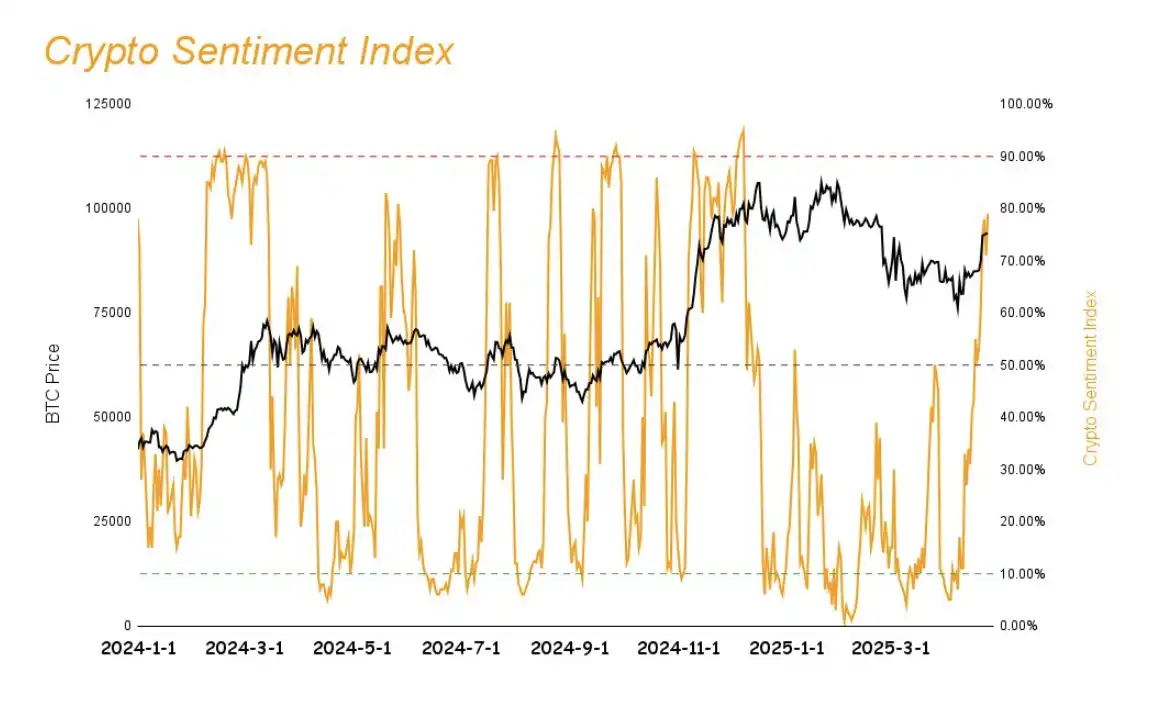
The market sentiment index rose from 55% last week to 79%, entering the bullish range overall.
Hot Tracks
MCP: Can it lead the future development direction of Crypto✖️AI?
MCP stands for Model Context Protocol (MCP), which was launched by Anthropic on November 25, 2024. It was not popular in the market after its launch. After Deepseek impacted the existing AI software, the market began to pay attention to the optimization algorithm and resource scheduling issues, changing the previous development mode of AI relying on accumulated computing power. Therefore, MCP standardized how external data and applications interact with large language models (LLMs) and provide context, which has been gradually valued by the market.
Recently, as the MCP-related token Dark on the Solana chain has performed well after its launch on Binance Alpha, investors in the market have begun to pursue and invest in MCP-related tokens, making MCP one of the few hot tracks in recent times.
The concept of MCP
Model Context Protocol (MCP) is an open source standard launched by Anthropic. It was originally an extension of the Claude ecosystem and aims to solve the fragmentation problem of AI models interacting with external tools and data. Now MCP has developed as a secure and standardized way to enable large language model-driven AI agents to interact with external systems to obtain real-time data. In actual use, MCP can act as a universal adapter, enabling AI to access content repositories, commercial tools, development environments, etc.
The core goal of MCP is to improve efficiency through standardized processes, enable AI agents to move from "understanding" to "doing", provide developers with efficient tools, and allow enterprises and non-technical users to easily customize their own agents. In this way, MCP can become a bridge between virtual intelligence and the real world, thereby promoting personalized innovation and development in various industries.
Working Principles and Technology of MCP
MCP Adoption Technology
The technical basis of MCP is JSON-RPC 2.0, which is a lightweight and efficient communication standard that supports real-time two-way interaction and high performance similar to WebSockets. It runs through a client-server architecture:
MCP Host: The application with which the user interacts, such as Claude Desktop, Cursor, or Windsurf, is responsible for receiving requests and displaying results.
MCP Client: Embedded in the host, establishes a one-to-one connection with the server, handles protocol communications, and ensures isolation and security.
MCP Server: A lightweight program that provides specific functionality and connects to local (such as desktop files) or remote (such as cloud API) data sources.
The transmission methods include:
Stdio: standard input and output, suitable for local rapid deployment, such as file management, with latency as low as milliseconds.
HTTP SSE: Server push events, supports remote real-time interactions, such as cloud API calls, and is suitable for distributed scenarios.
How it works
MCP adopts a client-server architecture. In simple terms, if the MCP host wants to retrieve data or perform operations, it needs to communicate and collaborate between the MCP client and the MCP server. To ensure efficiency and security, MCP assigns a dedicated client to each server to form a one-to-one isolated connection. Its core components include:
Host: User portal, such as Claude Desktop, responsible for initiating requests and displaying results, and is the "face" of interaction.
Client: Communication intermediary, using JSON-RPC 2.0 to interact with the server, managing requests and responses, and ensuring isolation.
Server: A provider of functionality that connects to external resources and performs tasks, such as reading a file or calling an API.
Flexible transmission methods:
Stdio: Local deployment, suitable for fast access to desktop files or local databases, with latency as low as milliseconds.
HTTP SSE: remote interaction, supports cloud API calls, and has strong real-time performance.
Advantages of MCP
MCP solves the current challenges faced in AI applications through standardized interfaces:
Real-time access: AI can obtain the latest data in a very short time.
Security and control: Direct access to data avoids intermediate storage, with 98% reliability in permission management, and users can restrict AI to access only specific files.
Low computational load: No need to embed vectors, reducing computational cost by about 70%.
Flexibility and scalability: The number of connections is reduced from the traditional 100 million to 20,000, greatly simplifying the configuration process.
· Interoperability: One MCP Server can be reused by multiple models.
· Vendor flexibility: Switching LLMs does not require restructuring infrastructure, similar to USB-C compatibility.
Autonomous agent support: Enables AI to dynamically access tools and perform complex tasks.
MCP Ecosystem Project
Dark
Dark is an experimental MCP network based on Solana, focusing on the Trusted Execution Environment (TEE). Dark aims to achieve innovation in decentralized technology by automatically integrating new tools and on-chain interactions, but most of the project features have not been launched. It is currently in the concept stage and has issued a token, DARK.
SkyAI
SkyAI is a native AI infrastructure based on BNB Chain, providing multi-chain data access and AI agent deployment. The project is still in the conceptual stage, and the actual product has not yet been launched. The token has been issued, and the token is SKYAI. With a market value of 43 million US dollars, it is the leading project in the MCP track.
Solix
Solix is a DePIN network that uses MCP and focuses on intelligent bandwidth sharing. Users can share bandwidth and get rewards through browser extensions, covering 63 countries around the world. The project technology is implemented quickly, but user participation and the sustainability of the economic model need to be verified. The project has not issued any coins at this stage.
HighKey
HighKey is a DeFAI project, compatible with MCP and DARP protocols, focusing on DeFi arbitrage and professional analysis. It has issued a token called HIGHKEY, with a small market value of only $5.68 million. The project has clear development functions, but still needs to improve user experience and differentiation.
DeMCP
DeMCP is a decentralized MCP project that focuses on trust and security and provides SSE proxy services. No tokens have been issued yet and it is still in the development stage, and actual products need to be demonstrated.
UnifAI
UnifAI is a DeFAI project that provides on-chain and off-chain task execution capabilities. Its flagship product UniQ simplifies complex on-chain operations. Although it has not issued a coin, it has launched a points program.
Future Development Direction
At present, most Web3 AI projects based on the MCP protocol are in the early stages of development, and substantive products have not yet been released, but some have issued tokens. Although MCP is an emerging hot spot in the AI subdivision track at this stage, given the previous experience of the failure of the AI Agent track, it is still necessary to be cautious about whether the MCP track project is just a flash in the pan for the issuance of AI Meme assets, or whether it can really make products that promote the development of the AI track. Therefore, the future development direction of MCP should focus mainly on the implementation and application of decentralized technologies. With the rapid development of AI and blockchain technology, MCP will continue to optimize its technical architecture to support more efficient computing and data sharing. In addition, MCP will strive to improve interoperability, simplify the use process for developers, and promote the popularization of decentralized applications.
Overall overview of market themes

Data source: SoSoValue
Based on weekly returns, the AI track performed best, while the Cefi track performed worst.
AI track: In the AI track, TAO, RENDER, FET, WLD, and FARTCOIN account for a large proportion, with a total share of 86.32%. This week, their increases were 50.96%, 18.93%, 53.36%, 33.58%, and 29.95%, respectively. The average increase was higher than that of projects in other tracks, making the AI track the best performing.
Cefi track: BNB, BGB, and OKB account for a large proportion in the Cefi track, with a total share of 89.97%. This week, their increases were 2.35%, 2.51%, and 2.29%, respectively. The average increase was lower than that of projects in other tracks, making the Cefi track the worst performer.
Crypto Events Next Week
Wednesday (April 30) The revised annualized quarterly rate of real GDP in the first quarter of the United States; the annual rate of the core PCE price index in March; and the number of ADP employment in April in the United States
Thursday (May 1) US April ISM Manufacturing PMI
Friday (May 2) US April seasonally adjusted non-farm payrolls; US unemployment rate for April
Summarize
The cryptocurrency market has seen a significant upward trend this week, with market sentiment shifting from a downturn to a positive one. This change was mainly due to the easing of US policies and the new SEC chairman's friendly attitude towards the crypto industry. As the policy environment changes, investors' confidence in the market has gradually recovered, leading to capital inflows into the cryptocurrency market and driving up prices. However, the market still needs to be wary of economic recession and uncertainty in tariff policies, which may continue to affect market trends. While enjoying market growth, investors also need to remain cautious to cope with possible fluctuations.
Projects such as Solana and Synthetix show potential for recovery, especially with positive progress in technology upgrades and community support. Solana's accelerated development and Synthetix's innovative initiatives have attracted more investors' attention, and these projects are expected to continue to expand their market influence in 2025. However, projects such as Omni face selling pressure from token unlocking, which may have a negative impact on their prices. Investors should make reasonable allocations based on the specific circumstances of the project and the market environment to avoid potential risks.
Although the overall industry trend is positive, the market is still facing the uncertainty of the upcoming economic recession and tariffs in the United States, so this week's rise can only be seen as a rebound from the oversold situation in the previous period, and cannot be seen as a reversal of the market. Next week, there will be more macro data released, including:
· Revised annualized quarterly rate of real GDP in the first quarter of the United States;
· U.S. core PCE price index annual rate in March;
· US ADP employment in April; US ISM manufacturing PMI in April;
· U.S. non-farm payrolls for April, seasonally adjusted; U.S. unemployment rate for April.
These data can affect future market trends. Investors are advised to maintain moderate positions, do a good job of risk management, and wait for policies to become clear. This will be the best strategy to deal with the current market.















